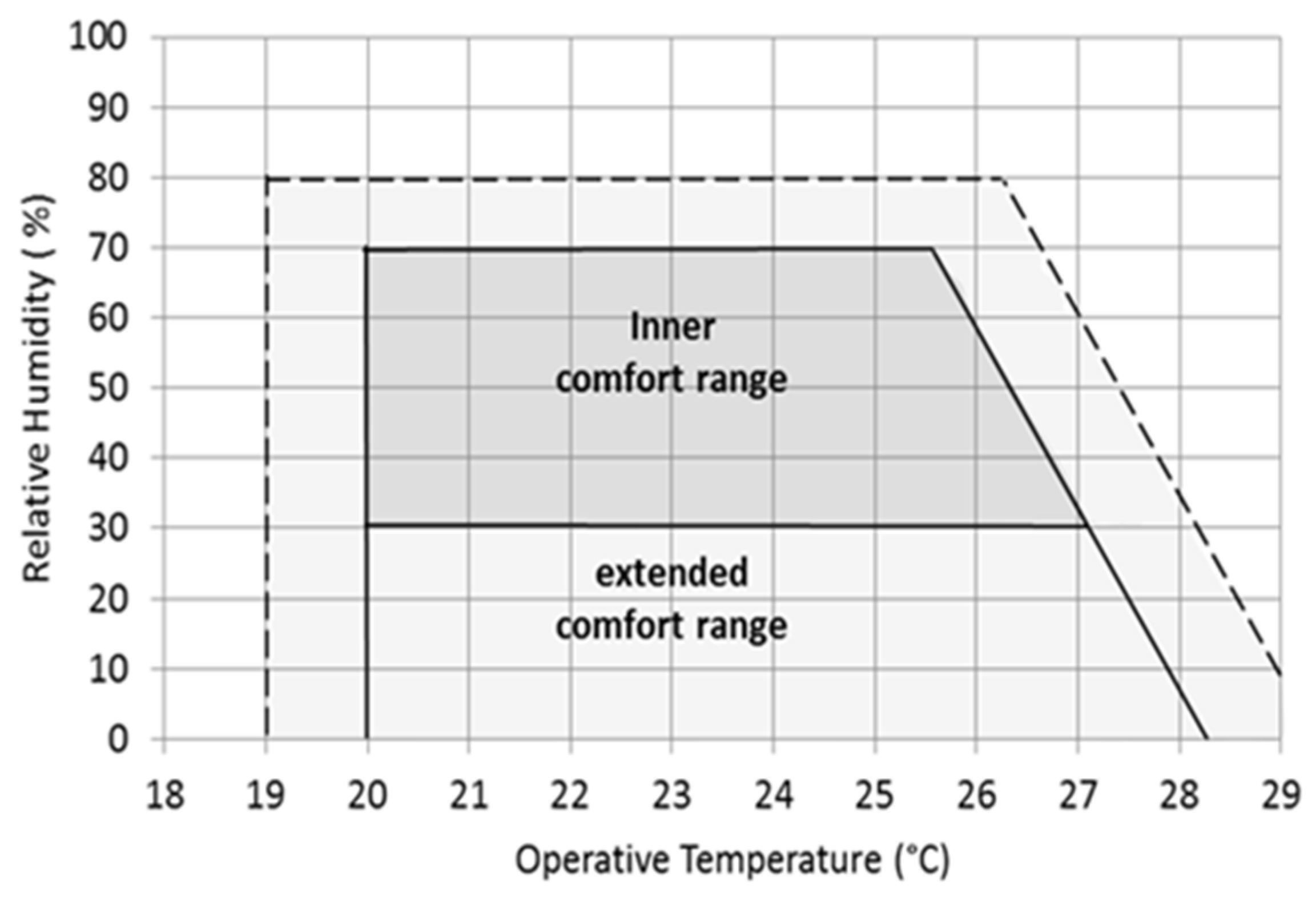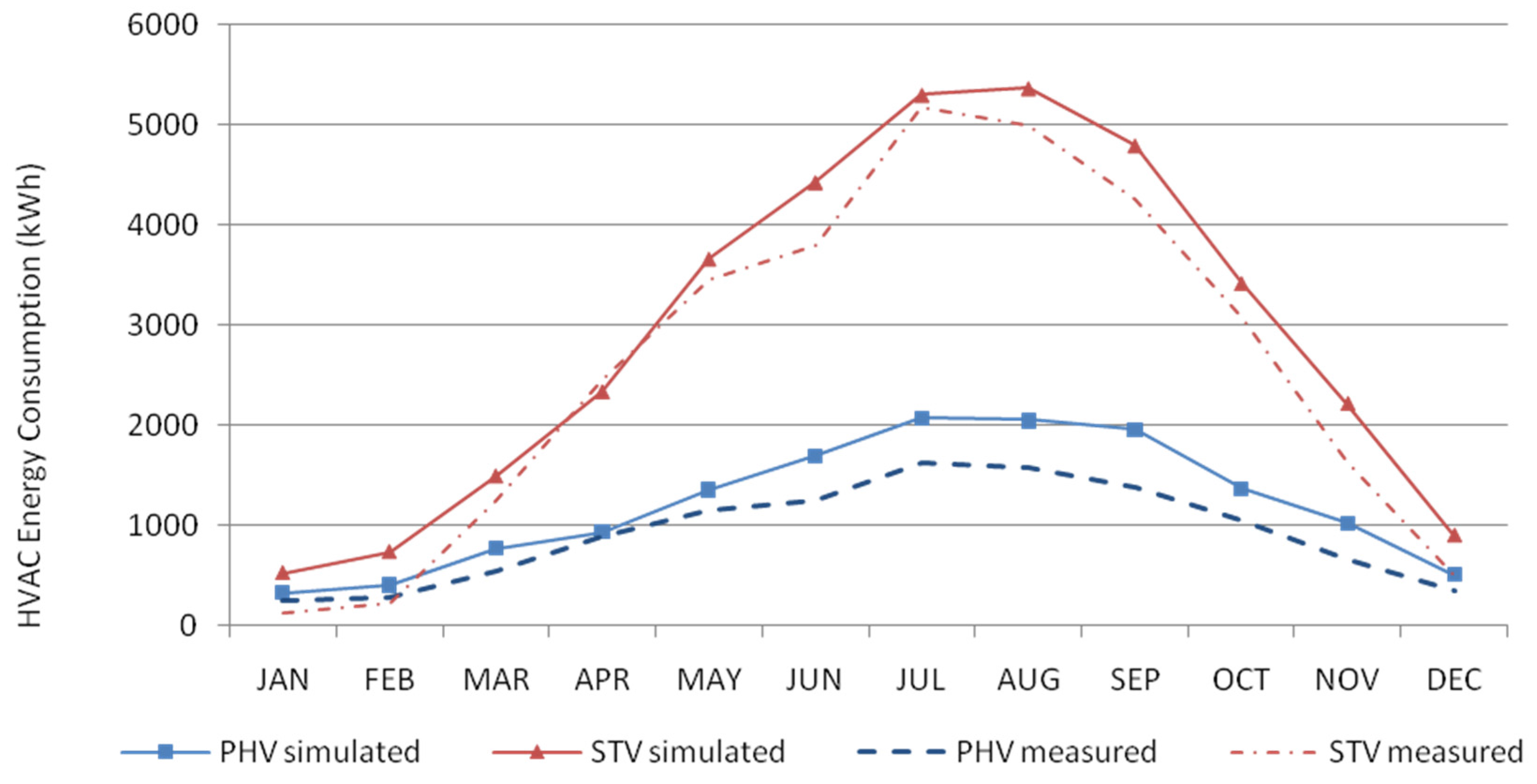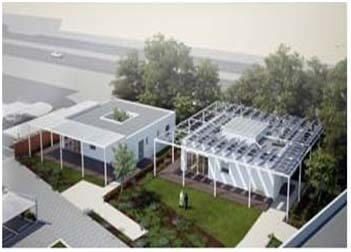The Present and Future Energy Performance of the First Passivhaus Project in the Gulf Region
Abstract
:1. Introduction
1.1. The Passivhaus Standard
| Criteria | Requirement |
|---|---|
| Heating Demand | Specific space heating demand ≤ 15 kWh/(m2a) Or alternatively: heating load ≤ 10 W/m2 |
| Cooling Demand (including dehumidification) | Total cooling demand ≤ 15 kWh/(m2a) + 0.3 W/(m2aK).DDH Or alternatively: cooling load ≤10 W/m2 AND cooling demand ≤4/(kWh/m2aK)× ϑe + 2 × 0.3 W/(m2aK) × DDH – 75 kWh/(m2a) but not greater than: 45 kWh(m2a) + 0.3 W/(m2aK) × DDH where ϑe is the annual mean outdoor temperature in °C and DDH is the Dry Degree Hours (time integral of the difference between the dew-point temperature and the reference temperature of 13 °C throughout all periods during which this difference is positive) |
| Total Primary Energy | Energy demand ≤ 120 kWh/(m2a) |
| Air Tightness | Pressure test result, n50 ≤ 0.6 h−1 |
| Thermal Comfort | Thermal comfort must for all living areas year-round with not more than 10% of the hours in any given year over 25 °C |
1.2. Thermal Comfort
| Environmental | Personal | Contributing Factors |
|---|---|---|
| Air temperature | Metabolic Rate | Food and drink |
| Air movement | Clothing | Body shape |
| Humidity | State of health | Subcutaneous fat |
| Radiation | Acclimatization | Age and gender |
1.3. Thermal Comfort Indices and Graphs

1.4. Climate Change
1.5. Future Weather Files
1.6. Qatar Passivhaus Project


1.7. Qatar’s Climate
2. Research Methodology
3. Results
3.1. Qatar Morphed Weather Data CCWorldWeatherGen Was Used to Morph the Current Historical Weather Data Set into the Projected 2080 Forecast

3.2. PHV and STV Technical Features
| Construction | PHV | STV |
|---|---|---|
| Wall | 200 mm block work + 380 mm Polystyrene layer | 300 mm block work + 50 mm cavity in between |
| Roof | 200 mm Cast concrete + 380 mm Polystyrene layer | 200 mm Cast concrete + 100 mm Polystyrene layer |
| Floor | 250 mm Cast concrete + 200 mm Polyfoam layer | 250 mm Cast concrete |
| Glazed Surfaces | Triple glazing—6 mm clear and coated glass—double 12 mm cavity | Double glazing—6 mm clear float glass—single 12 mm cavity |
| Construction | PHV | STV | Passivhaus Requirement |
|---|---|---|---|
| Walls | 0.084 | 1.31 | 0.10–0.15 |
| Roof | 0.084 | 0.30 | 0.10–0.15 |
| Floor | 0.11 | 0.50 | 0.10–0.15 |
| Glazed surfaces | 1.11 | 2.61 | 0.85 |
3.3. Thermal Envelope Performance (TEP)


3.4. Energy Consumption



3.5. Thermal Comfort





4. Discussion
5. Conclusions
Acknowledgments
Author Contributions
Conflicts of Interest
References
- Abu Bakar, N.N.; Hassan, M.Y.; Abdullah, H.; Rahman, H.A.; Abdullah, M.P.; Hussin, F.; Bandi, M. Energy efficiency index as an indicator for measuring building energy performance: A review. Renew. Sustain. Energy Rev. 2015, 44, 1–11. [Google Scholar] [CrossRef]
- International Energy Agency Statistics. Available online: http://www.iea.org/statistics/ (accessed on 1 October 2015).
- The United Nations Environmental Programme. Available online: http://www.unep.org/ (accessed on 1 October 2015).
- Pérez-Lombard, L.; Ortiz, J.; Pout, C. A review on buildings energy consumption information. Energy Build. 2008, 40, 394–398. [Google Scholar] [CrossRef]
- De Boeck, L.; Verbeke, S.; Audenaert, A.; de Mesmaeker, L. Improving the energy performance of residential buildings: A literature review. Renew. Sustain. Energy Rev. 2015, 52, 960–975. [Google Scholar] [CrossRef]
- Lahn, G.; Preston, F. Targets to promote energy savings in the gulf cooperation council states. Energy Strategy Rev. 2013, 2, 19–30. [Google Scholar] [CrossRef]
- Meltzer, J.; Hultman, N.; Langley, C. Low-carbon energy transitions in Qatar and the Gulf Cooperation Council Region, 2014. Available online: file:///F:/May%20Khalfan/Low%20carbon%20energy%20transitions%20in%20Qatar%20and%20GCC%20region%202014.pdf (accessed on 1 October 2015).
- The Passive-On Project. Available online: http://www.eerg.it/passive-on.org/en/cd.php (accessed on 1 October 2015).
- Schnieders, J.; Hermelink, A. CEPHEUS results: Measurements and occupants’ satisfaction provide evidence for passive houses being an option for sustainable building. Energy Policy 2006, 34, 151–171. [Google Scholar] [CrossRef]
- Passepedia the Passive House Resource. Available online: http://passipedia.org/ (accessed on 1 October 2015).
- The UK Passive House Organization, PHPP version out now. Available online: http://www.passivhaustrust.org.uk/news/detail/?nId=268#.VhfUJvlVhBc (accessed on 1 October 2015).
- International Passive House Association, Number of passive house square meter reaches one million. Available online: http://www.passivehouse-international.org/index.php?page_id=76&y=2014 (accessed on 1 October 2015).
- Nicol, J.F.; Humphreys, M.A. Adaptive thermal comfort and sustainable thermal standards for buildings. Energy Build. 2002, 34, 563–572. [Google Scholar] [CrossRef]
- Szokolay, S.V. Introduction to Architectural Science: The Basis of Sustainable Design, 2nd ed.; Elsevier/Architectural Press: Amsterdam, The Netherlands, 2008. [Google Scholar]
- Taleghani, M.; Tenpierik, M.; Kurvers, S.; van den Dobbelsteen, A. A review into thermal comfort in buildings. Renew. Sustain. Energy Rev. 2013, 26, 201–215. [Google Scholar] [CrossRef]
- Carlucci, S. Thermal Comfort Assessment of Buildings. 2013. Available online: http://search.ebscohost.com.ezproxy.liv.ac.uk/login.aspx?direct=true&db=cat00003a&AN=lvp.b2808385&site=eds-live&scope=site (accessed on 1 October 2015).
- Peeters, L.; de Dear, R.; Hensen, J.; D’haeseleer, W. Thermal comfort in residential buildings: Comfort values and scales for building energy simulation. Appl. Energy 2009, 86, 772–780. [Google Scholar] [CrossRef]
- Evans, J.M. Evaluating comfort with varying temperatures: A graphic design tool. Energy Build. 2003, 35, 87–93. [Google Scholar] [CrossRef]
- Schnieders, J.; Feist, W.; Rongen, L. Passive houses for different climate zones. Energy Build. 2015, 105, 71–87. [Google Scholar] [CrossRef]
- National Research Council of the National Academies. Monitoring Climate Change Impacts; National Academies Press: Washington, DC, USA, 2010; Available online: http://search.ebscohost.com.ezproxy.liv.ac.uk/login.aspx?direct=true&db=cat00003a&AN=lvp.b2471353&site=eds-live&scope=site (accessed on 1 October 2015).
- Dirks, J.A.; Gorrissen, W.J.; Hathaway, J.H.; Skorski, D.C.; Scott, M.J.; Pulsipher, T.C.; Huang, M.; Liu, Y.; Rice, J.S. Impacts of climate change on energy consumption and peak demand in buildings: A detailed regional approach. Energy 2015, 79, 20–32. [Google Scholar] [CrossRef]
- Li, D.H.W.; Yang, L.; Lam, J.C. Impact of climate change on energy use in the built environment in different climate zones—A review. Energy 2012, 42, 103–112. [Google Scholar] [CrossRef]
- Jentsch, M.F.; James, P.A.; Bahaj, A.S. Climate change adapted simulation weather data: Implications for cities in hot, arid climates of the Middle East. 2010. Available online: http://www.uni-weimar.de/Bauing/energy/Publications/WREC_XI_Jentsch_climate_change_Middle_East.pdf (accessed on 1 October 2015).
- Jentsch, M.F.; Bahaj, A.S.; James, P.A.B. Climate change future proofing of buildings—Generation and assessment of building simulation weather files. Energy Build. 2008, 40, 2148–2168. [Google Scholar] [CrossRef]
- Haase, M. Development of future weather data set based on SRES scenario. Available online: http://www.irbnet.de/daten/iconda/CIB21159.pdf (accessed on 1 October 2015).
- Weather data for simulation. Available online: http://apps1.eere.energy.gov/buildings/energyplus/weatherdata_simulation.cfm (accessed on 1 October 2015).
- Guan, L. Preparation of future weather data to study the impact of climate change on buildings. Build. Environ. 2009, 44, 793–800. [Google Scholar] [CrossRef]
- Meteonorm website. Available online: http://meteonorm.com/ (accessed on 1 October 2015).
- Remund, J.; Müller, S.; Schilter, C.; Rihm, B. The use of Meteonorm weather generator for climate change studies. 2010. Available online: https://www.researchgate.net/publication/253793832_The_use_of_Meteonorm_weather_generator_for_climate_change_studies (accessed on 1 October 2015).
- Climate Change World Weather File Generator for World-Wide Weather Data—CCWorldWeatherGen. Available online: http://www.energy.soton.ac.uk/ccworldweathergen (accessed on 1 October 2015).
- Melly, P. Doha Passivhaus sets the standard. MEED: Middle East. Econ. Dig. 2014, 58, 30–31. [Google Scholar]
- Hartman, H. Passivhaus Qatar: An AECOM-designed prototype villa is soon to trial in the extreme heat of the emirate. Archit. J. 2013, 237, 56–57. [Google Scholar]
- Barwa city development. Available online: https://www.waseef.qa/en/barwa-city/ (accessed on 1 October 2015).
- Barwa group. Available online: http://www.barwa.com.qa/sites/English/BusinessSegments/QatarRealEstateInvestments/BarwaCity/SitePages/Home.aspx (accessed on 1 October 2015).
- Peel, M.C.; Finlayson, B.L.; McMahon, T.A. Updated world map of the Koppen-Geiger climate classification. Hydrol. Earth Syst. Sci. 2007, 11, 1633–1644. [Google Scholar] [CrossRef]
- Qatar Meteorology Department. Available online: http://qweather.gov.qa/ClimateNormals.aspx (accessed on 1 October 2015).
- Crawley, D.B.; Hand, J.W.; Kummert, M.; Griffith, B.T. Contrasting the capabilities of building energy performance simulation programs. Build. Environ. 2008, 43, 661–673. [Google Scholar] [CrossRef] [Green Version]
- IES website. Available online: http://www.iesve.com/about (accessed on 1 October 2015).
- UCLA. Energy design tools. Available online: http://www.energy-design-tools.aud.ucla.edu/ (accessed on 1 October 2015).
- IPPC, Special Report on Emission Scenarios. 2000. Available online: http://www.grida.no/publications/other/ipcc_sr/?src=/climate/ipcc/emission/index.htm (accessed on 1 October 2015).
© 2016 by the authors; licensee MDPI, Basel, Switzerland. This article is an open access article distributed under the terms and conditions of the Creative Commons by Attribution (CC-BY) license (http://creativecommons.org/licenses/by/4.0/).
Share and Cite
Khalfan, M.; Sharples, S. The Present and Future Energy Performance of the First Passivhaus Project in the Gulf Region. Sustainability 2016, 8, 139. https://doi.org/10.3390/su8020139
Khalfan M, Sharples S. The Present and Future Energy Performance of the First Passivhaus Project in the Gulf Region. Sustainability. 2016; 8(2):139. https://doi.org/10.3390/su8020139
Chicago/Turabian StyleKhalfan, May, and Steve Sharples. 2016. "The Present and Future Energy Performance of the First Passivhaus Project in the Gulf Region" Sustainability 8, no. 2: 139. https://doi.org/10.3390/su8020139






